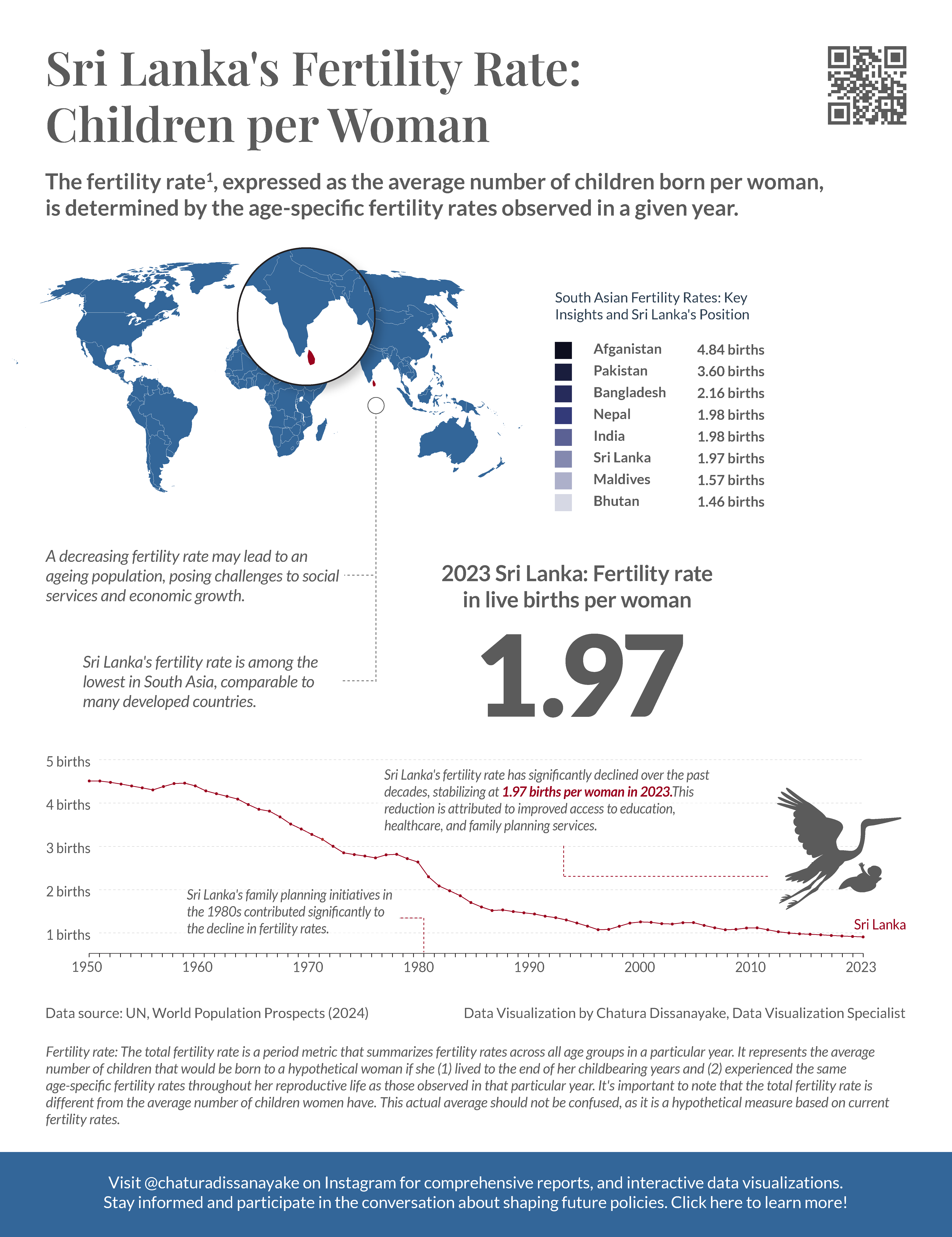Sri Lanka's Fertility Rate: Children per Woman
Project Overview
This project is a data-driven infographic designed using Adobe Illustrator, using information from UN World Population Prospects (2024) and other relevant sources mentioned in the infographic. The goal is to present Sri Lanka's fertility rate trends, compare them to regional counterparts, and highlight the potential socio-economic implications of declining birth rates.
The infographic was designed with the intention of making complex demographic data easily understandable for a general audience, policymakers, and researchers.
Decision-Making Process & Rationale
1. Choosing the Topic
- The fertility rate is a key demographic indicator affecting economic growth, workforce trends, and social policies.
- Sri Lanka’s declining birth rate is comparable to developed countries, making it an interesting case for analysis.
- A well-structured visual representation helps communicate the impact of changing demographics effectively.
2. Data Collection & Validation
- Data was sourced from reputable organizations like the United Nations (UN) World Population Prospects 2024.
- The infographic also includes a regional comparison of South Asian countries, giving a broader context.
- Historical trends from 1950 to 2023 were analyzed to show policy impact and future implications.
3. Key Insights Highlighted
- Declining Trend: Sri Lanka’s fertility rate has significantly dropped, stabilizing at 1.97 births per woman in 2023.
- Comparative Analysis: Sri Lanka has one of the lowest fertility rates in South Asia.
- Policy Effects: Family planning initiatives in the 1980s played a crucial role in reducing fertility rates.
- Future Impact: The decline may lead to an aging population and economic challenges, similar to trends seen in countries like Japan and South Korea.
Design Process in Illustrator
Since this was created in Adobe Illustrator, a structured approach was used to ensure clarity, accuracy, and visual appeal.
1. Layout & Composition
- Balanced Structure: Information was arranged in a logical sequence—starting with a global map, followed by Sri Lanka’s trends, and then comparisons with other countries.
- Focal Point: The 1.97 births per woman (2023) statistic was made bold and prominent for easy recognition.
- White Space: Used effectively to avoid clutter and maintain readability.
2. Color & Typography Choices
- Color Gradient for Regional Comparison: Darker shades indicate higher fertility rates, while lighter tones represent lower rates.
- Professional Typography: A mix of serif and sans-serif fonts for a formal and engaging look.
- Minimalist Color Palette: To maintain clarity and data accuracy without overwhelming the viewer.
3. Data Visualization Techniques
- Timeline Graph: Used to illustrate the decline in fertility rate over the decades.
- Bar Comparison: Helps quickly convey Sri Lanka’s position relative to other South Asian countries.
- Icons & Illustrations: A stork carrying a baby adds a symbolic and engaging element to the design.
Implementation for Digital Use (Figma Integration)
Even though this was originally designed in Illustrator, it can be imported into Figma for:
- Interactive Prototyping: Clickable elements for more detailed insights.
- Animation Effects: Showing trends dynamically.
- Responsive Adjustments: For mobile-friendly versions.
Final Thoughts & Impact
- The infographic transforms complex data into a visually engaging story, making it easier for the audience to grasp the significance of fertility trends.
- By using accurate data, clear visuals, and effective storytelling, this project serves as an educational and policy-driven resource.
Would you like assistance in converting the Illustrator file into a Figma-friendly format, such as setting up interactive elements or a digital version?
Tools used
Topics
Share
Reviews
0 reviews
You might also like

Splid Redesigned (Now in development as GroupTab)

Case Study: Designing AI Lister in UX Pilot

SS Fire Pits

Swift: A mobile design system

Accessible Sign-Up Flow for a Residential Management Platform

QR Digital Menu for Cafe :)
Popular Courses

UX Design Foundations

KPIs & OKRs for Products











